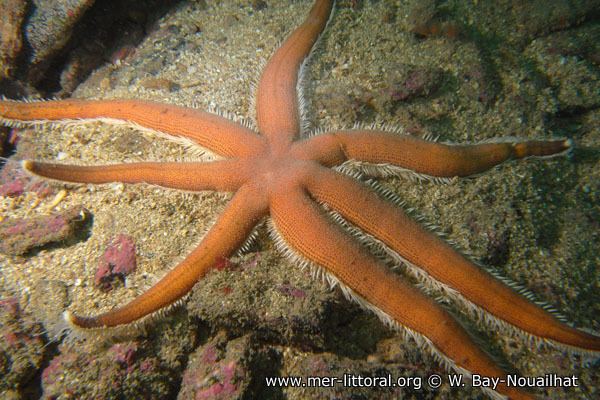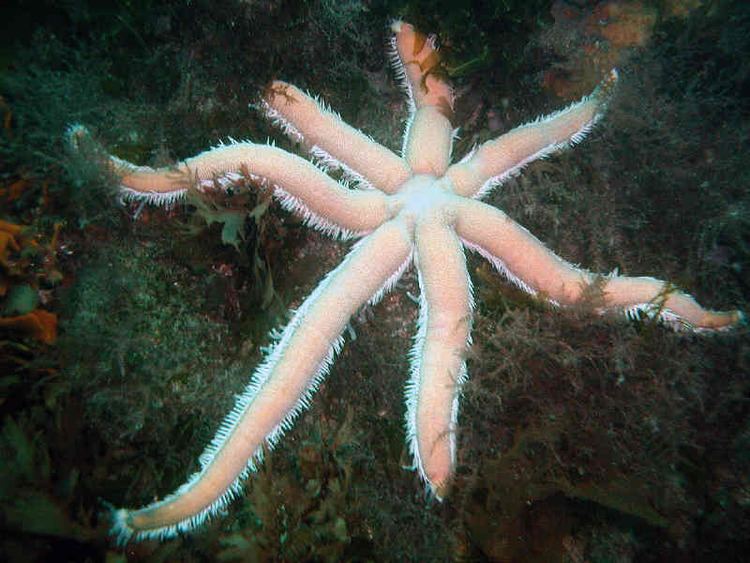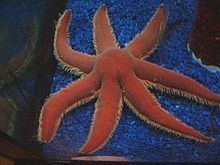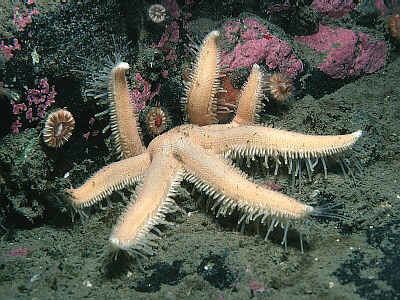Family Luidiidae | Class Asteroidea Rank Species | |
 | ||
Similar Luidia, Paxillosida, Luidia sarsii, Astropecten irregularis, Marthasterias glacialis | ||
The seven-armed sea star (Luidia ciliaris) is a species of sea star (starfish) in the family Luidiidae. It is found in the eastern Atlantic Ocean and the Mediterranean Sea.
Contents

Description

L. ciliaris is an orangeish-brown colour and has seven long arms radiating from a small disk. It is a large but fragile sea star, growing to forty centimetres across, and easily losing its arms (which afterwards regenerate). The arms have parallel sides and taper only near the tip. They have a conspicuous fringe of white spines along the margins. The upper surface is clothed in paxillae, spines shaped like a pillar with a flat top bearing tiny spinules. There are also many-lobed, nipple-like papillae. There are no marginal plates on the upper side of the arms but those on the lower side bear pedicellariae with two valves. The tube feet are long and numerous. They do not have suction pads but have two sets of terminal bulbs. The gonads are arranged in two rows along the length of the arms. There is a mouth at the centre of the underside, an oesophagus and a cardiac stomach but no intestine, pyloric stomach or anus.
Distribution and habitat

L. ciliaris occurs on the seabed in the eastern Atlantic Ocean from Norway and the Faroe Islands southwards to Cape Verde and the Azores and in the Mediterranean Sea. It is found in the neritic zone at depths down to four hundred metres, mainly on soft sediments into which it sometimes burrows, but sometimes on rock.
Biology

L. ciliaris is a predator and scavenger and feeds predominantly on other echinoderms. A study in the Irish Sea found that the brittle stars, Ophiothrix fragilis and Ophiura albida, and the sea urchin, Psammechinus miliaris, formed the chief items of prey. The brittle star Ophiocomina nigra was also consumed but in lesser quantities because it had more efficient escape strategies.

L. ciliaris moves rapidly in comparison with other sea stars. It hoists itself up on the tips of its arms, in which position it can "walk", before launching itself at its prey. The ring of plates around its mouth are extensible or can even be ruptured to enable it to ingest food items much bigger than the normal size of its mouth. In this way it can pounce on a brittle star twenty-five centimetres in diameter and completely engulf it. Undigested remains are ejected through the mouth.

L. ciliaris breeds in early summer. Each female releases millions of eggs into the water column and this stimulates the release of sperm by the males. About four days after fertilisation, the zygotes develop into bipinnaria larva which form part of the plankton. After several moults the seven arms can be seen developing in what is called the "rudiment" which is connected to a stalk which has several bands of cilia. The larva reaches a length of thirty-five millimetres in 3 to 4 months. It does not become a brachiolaria larva as is the case in most sea star taxa. Instead, it settles on the sea bed and metamorphosis takes place. Functional tube feet appear in the juvenile before the larval tissue is fully reabsorbed.
